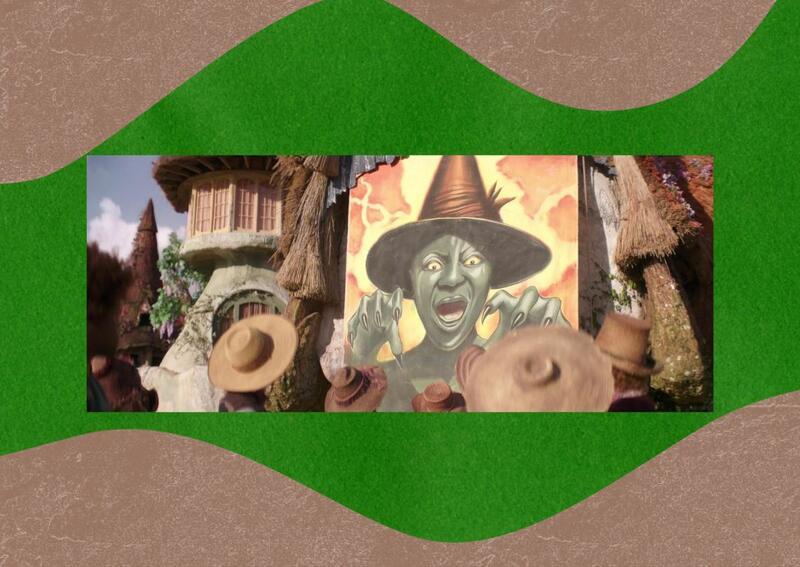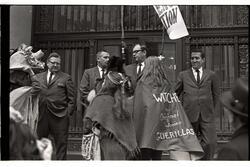Propaganda’s Role in Creating the "Wicked"
In bold, black ink, a bent figure with a grossly tapered nose hovers over the bottom text of a poster. This description could be applied to various antisemitic propaganda of the 20th century or, curiously, the anti-Wicked Witch propaganda littering the background of the new Wicked movie. The 2024 film adaptation of the classic Broadway musical offers celebrity names and quite the press tour (finally some space to hold the lyrics of Defying Gravity). The story follows Elphaba (Cynthia Erivo) on her discovery of friendship and craft at Shiz University, a prestigious school of magic.
Elphaba is assigned to share a room with an unlikely roommate, Glinda (Ariana Grande). What makes these two an odd pair is that Glinda is blonde and Elphaba is…green. As a result of a cursed affair between Elphaba’s mother and the Wizard of Oz, Elphaba’s skin is permanently shaded green. This feature separates her from the rest of Oz, leaving her vulnerable to the prejudices of her family, classmates, and internal judgement. Though she finds moments of acceptance, those in power ultimately turn the world of Oz against her. Every Ozian complaint is manufactured to be a symptom of Elphaba’s wickedness, and residents of the fictional world live surrounded by the witch’s evil long-nosed caricature. Elphaba’s humanity is piled under mountains of lies and illustrated propaganda, mirroring non-fictional instances of scapegoating.
Graphic design can be a tool of hatred. Illustration allows oppressors to solidify propaganda in a static form. As the Wizard of Oz (Jeff Goldblum) says while he is betraying Elphaba, “The best way to bring folks together is to give them a real good enemy.” And for an oppressor to successfully create an enemy, they must curate this lasting image of otherness. That line said by the wizard was what first clued me in to the parallels between the fictitious Ozian government and that of Nazi Germany. As I watched the rest of the film and reflected on the previous scenes, I noted a glaringly evident analogy — both stories are centered on the rise of a false political savior, a scapegoat, and a society’s willingness to hate.
A nice young wizard, resembling nothing of the nation’s troubles, promised to implement a system that targets evil. And implement it he did. Appointed by the German president in 1933, Hitler held the power of a country in social, economic, and political disaster. Germany was in tremendous debt and financial collapse after the loss of WWI. As suffering grew, so did citizens' hunger for a savior. The Germans heard Hitler’s promises and instantly believed in them, desperate for some form of protection. Hitler provided this protection through the bonding exercise of hatred. Waving his magic wand, Jews and other “undesirables” began to disappear from German public view. Carting away proof of humanity into death camps, Jews became remembered purely through propaganda. The only image of a Jew that the Nazis offered to the public eye was one surrounded by text describing their evilness. The static picture of a power-hungry, greedy, and evil Jew replaced the flesh and blood of Jewish humanity. This is the same strategy applied to our fictional Witch of the West.
Oz, too, was in a state of political upheaval. The Wizard appeared and assumed the messianic role prophesied by the Magical Wise ones who had assured the people of Oz that someone special would come to power and restore the nation’s glory. He restores this glory–or rather, seems to do so—by distorting his abilities and deceiving his citizens into believing he is the only path to greatness. Once in power, the Wizard slowly starts taking away the rights of the animals, who have historically lived among humans and worked at the highest levels of society. He prevents the animals from learning to speak, literally silencing them.
This suppression is demonstrated by Dr. Dillamond – who is a scapegoat goat. One of Elphaba’s professors at Shiz University, Dr. Dillamond breaks the societal gag rule about the subordination of the animals and speaks out. He tells his class of the discrimination the animals are subjected to and, as a result, is removed as a professor. The only student who speaks against his removal is Elphaba, for she knows what it is like to have her humanity denied. Despite rampant propaganda and political disfigurement of facts, Elphaba recognizes the animals’ suffering and refuses to be complicit in it.
Munchkins in Munchkinland and Germans living two miles from Majdanek were happy to accept propaganda because it provided them with an easy narrative that reinforced pre-existing beliefs systematically instilled in them. Deception exists far beyond Oz or the past, plaguing today’s news sources and political platforms. Though fictional, Wicked demonstrates the all too real social and political power of propaganda. Throughout Elphaba’s life, the animals were the only group that consistently resisted stories of her as a villain. The midwife-bear that delivers the green wicked witch, the goat-professor who believes in her, and the winged monkey-guards that serve her are all united by the shared understanding of what it means to be hated.
When consuming media, it is the responsibility of the viewer to recognize whose position the image serves, what bias it holds, and if it is a representation of the truth. As facts are becoming murkier and put up for debate, it is crucial to critically examine all media, ensuring that it is not concealing the truth for the sake of fabricating an enemy.
This piece was written as part of JWA’s Rising Voices Fellowship.







